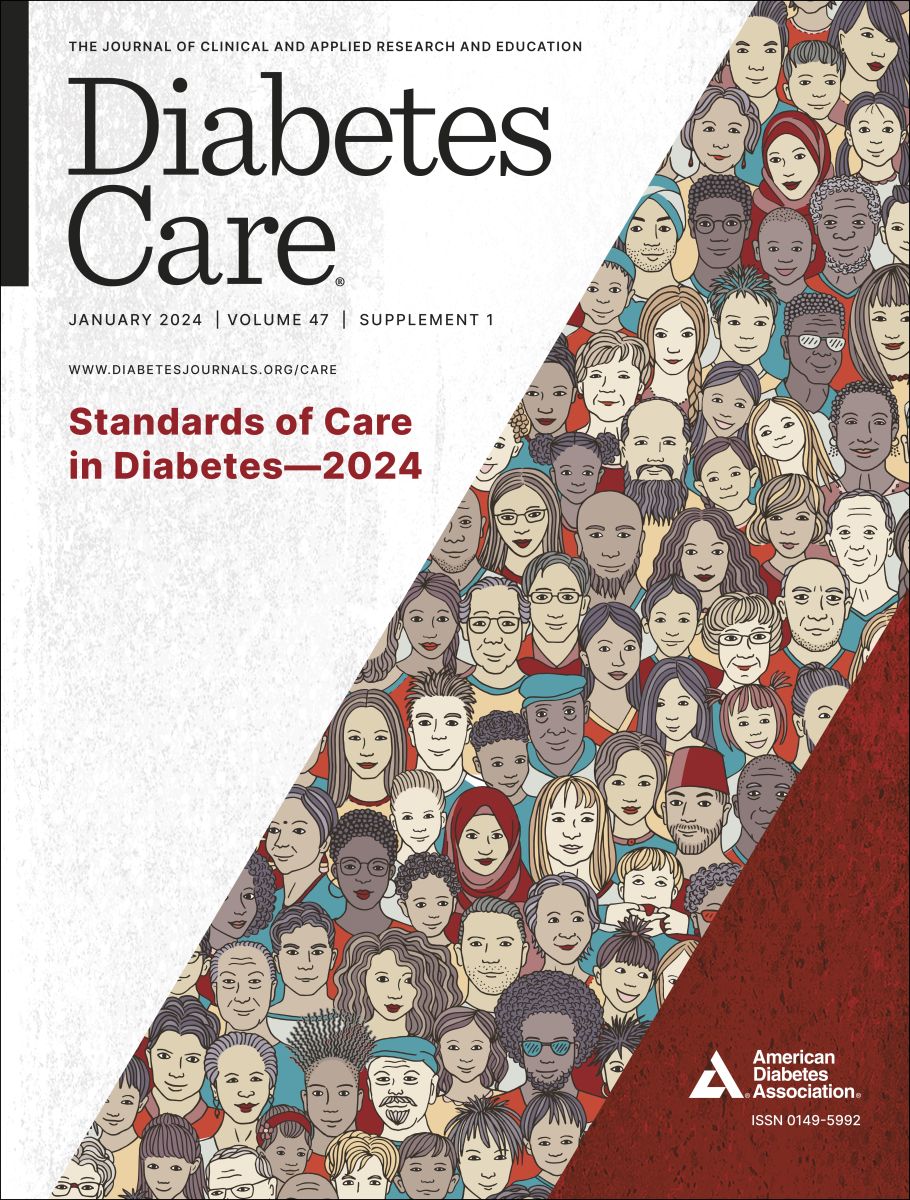Your Guide to the 2024 ADA Standards of Care
By Hope Warshaw
 The ADA has released its 2024 Standards of Care. These guidelines for diabetes care for healthcare providers are published each year following a review of new studies by experts.
The ADA has released its 2024 Standards of Care. These guidelines for diabetes care for healthcare providers are published each year following a review of new studies by experts.
The American Diabetes Association (ADA) has released its 2024 Standards of Medical Care in Diabetes. This essential diabetes care document, first published in 1989 and updated each year, is aimed at healthcare providers who care for and counsel people with or at risk for diabetes.
The update is conducted by the ADA’s Professional Practice Committee, which is composed of physicians, diabetes care and education specialists, and behavioral health scientists, with expertise in a range of diabetes-related areas, from cardiovascular health to diabetes technology.
While the Standards of Care have been created to advise healthcare professionals, knowledge of these guidelines can help people with diabetes be aware of and work with their healthcare providers to advocate to receive the best care possible. Below are top highlights of the 2024 ADA Standards of Care.
Like the previous year’s guidelines, the 2024 Standards continue to shine a light on the role of blood glucose, blood pressure, and lipid management, along with the use of medications that have been shown to benefit the heart, blood vessels, and kidneys. This concurrent approach to care has the goal of reducing the risks of diabetes related complications.
The ADA has also strengthened wording to support screening for and preventive steps to manage and prevent progression of numerous diabetes complications, from heart failure to non-alcoholic fatty liver disease, (common in people with type 2 diabetes) to peripheral arterial disease.
2024 updates to screening for diabetes
While evidence shows that early detection, and the use of early interventions, can prevent or delay complications, screening and the use of early interventions has still fallen short of ADA recommendations.
Screening for diabetes distress and depression
The Standards of Care now recommend that people with diabetes, their caregivers, and family members be screened for diabetes distress at least yearly, and potentially more frequently if warranted. Guidelines encourage healthcare providers to address diabetes distress using validated tools to measure this based on the age, type of diabetes and life stage of the individual.
The new update also encourages annual screening for depression in everyone with diabetes (more frequently in those with a history of or self-reported depression). People with a mental health challenge or diagnosis should be referred to behavioral health professionals for services.
Screening for prevention or delay of type 1 diabetes
With the FDA’s 2022 approval of Tzield (teplizumab), which now allows for the possibility of delaying the onset of type 1 diabetes in those at risk who are 8 years and older, the ADA offers additional guidance on screening and prevention of type 1 diabetes. The ADA’s Standards of Care now encourages those 8 and older with stage 2 type 1 diabetes to consider using Tzield to delay the onset of stage 3 type 1 diabetes.
Immunizations
 The latest ADA guidelines recommend that everyone with diabetes 6 months of age and older be up to date on COVID-19 vaccinations and boosters as well as the inactive or recombinant version of annual influenza vaccinations. Adults with diabetes 60 years of age and older are also encouraged to have the respiratory syncytial virus (RSV) vaccine as well as the high-dose quadrivalent inactivated influenza vaccine.
The latest ADA guidelines recommend that everyone with diabetes 6 months of age and older be up to date on COVID-19 vaccinations and boosters as well as the inactive or recombinant version of annual influenza vaccinations. Adults with diabetes 60 years of age and older are also encouraged to have the respiratory syncytial virus (RSV) vaccine as well as the high-dose quadrivalent inactivated influenza vaccine.
Bone Health
To reflect the increased risk of bone fractures in men and women with type 1 or type 2 diabetes, the ADA Standards made significant updates in the section on bone health to focus on assessing risk for fractures in older adults with diabetes as part of routine care. Updated guidelines recommend that both those aged 65 and older as well as anyone with risk factors for bone fractures have a DEXA (bone density) scan every two to three years. Since the use of some glucose-lowering medications are associated with an increase in falls and bone fractures, the use of medications with a high risk of hypoglycemia or adverse impact on bone health (such as TZDs) should be avoided. People at risk for bone fracture should, either through food consumption or supplements, get sufficient calcium and vitamin D and should also be counseled to do sufficient aerobic and weight-bearing physical activity for optimal bone health.
Diabetes technology for everyone
The section in the Standards of Care that addresses diabetes technology now begins with the following statement: “Diabetes devices should be offered to people with diabetes.”
The ADA increasingly emphasizes the value and importance of offering the latest devices – whether insulin pens, connected pens, glucose meters, CGMs, or automated insulin delivery (AID) systems – to people with diabetes along with education, follow-up, and support. The latest ADA Standards also recommends that continuous glucose monitors be offered to people with type 1 diabetes at the point of diagnosis, as well as to people with type 1 diabetes who are pregnant.
Notably, 2024 guidelines encourage healthcare providers to be proficient in the use of diabetes technology, with the understanding that it is critical for diabetes care providers to have enough knowledge about diabetes tech to offer their patients that they can educate them on their use and support them in their use over time.
For a person who is hospitalized, the new guidelines recommend that people with diabetes be able to use a CGM and AID system, in tandem with hospital-based glucose measurements for dosing decisions and assessment for potential hypoglycemia, whenever possible.
Weight management for prevention or management of type 2 diabetes
 “There is strong and consistent evidence that obesity management can delay the progression from prediabetes to type 2 diabetes and is highly beneficial in treating type 2 diabetes,” new guidance states.
“There is strong and consistent evidence that obesity management can delay the progression from prediabetes to type 2 diabetes and is highly beneficial in treating type 2 diabetes,” new guidance states.
The Standards promote the effectiveness of ongoing weight management programs to offer support to assist with weight loss and maintenance along with the use of one of the new weight management medications that in studies demonstrate weight reductions over time upwards of 15% of body weight. These medications are GLP-1 agonists such as semaglutide (Ozempic, Wegovy, and Rybelsus), or dual GLP/GIP agonists like tirzepatide (Mounjaro and Zepbound). These medications also improve glucose levels and other risk factors.
The Standards now acknowledge that there’s a range of health benefits based on the amount of weight that is lost. Losing 3-7% from a starting weight can improve glucose levels and improve cardiovascular risk factor, where the loss of greater than 10% of starting weight may, if weight loss is maintained, lead to type 2 diabetes remission, improvements in liver health and other risk factors.
Glucose-lowering medications that offer additional health benefits
As has been true the last few years, the Standards promote the value of a number of newer categories of glucose-lowering medications, that also confer other health benefits, such as protecting the heart and kidneys. Though benefits of their use have been seen repeatedly, they remain woefully underutilized. The Standards continue to encourage the prioritization of glucose-lowering medications, including SGLT-2 inhibitors and incretin-based therapies like GLP-1 agonists and dual agonists, in assisting with more quickly and effectively achieving individualized treatment goals.
Kidney health
One of the updates this year to management of kidney health is the guidance to include a blood pressure medication such as an ACE inhibitor or ARB. Newer evidence shows these medications can also reduce cardiovascular events, such as a heart attack or stroke. An ACE inhibitor or ARB continues to be the first medication recommended to manage blood pressure in people with diabetes. The Standards also provide guidance on when a person should be referred to a nephrologist.
About this series
Each year the American Diabetes Association updates its Standards of Medical Care in Diabetes based on current science. We’ve also translated key areas of the up-to-date guide into plain English so you know how to stay healthy living with diabetes:
-
Current Targets for Lipids, Cholesterol, Blood Pressure, Time in Range, and A1C
-
How to Avoid Nerve Damage in Your Hands and Feet With Diabetes
Photo credits: American Diabetes Association (top); iStock (all other photos).








